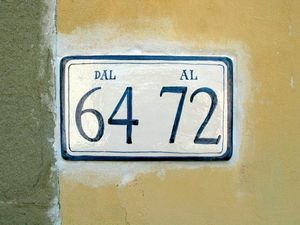These are the Italian equivalents of Road, Street, Gardens, Avenue, etc. Fortunately for us, there are fewer in Italian than in English, and by far the commonest are via (street) and piazza (square). The word street or square is followed by the name of that street or square; confusingly in Italy there is (almost always) a standard group of names that are used in every single city and town the length and breadth of Italy. For example, every town has a piazza del Duomo and a piazza della Repubblica plus a whole list of other names that would seem almost compulsory. These names tend to refer to historical figures (piazza Garibaldi), or political ones (usually dead!) such as via Aldo Moro. Favorites during Mussolini’s times have Russian origins and are unpronounceable for the Tuscans that live in them! Possibly the most difficult of all are those roads that are named after dates; via XXV Aprile, and viale XI Agosto – and yes the numbers are all written in Roman numerals too, so if you don’t know them, you are going to have to learn them all!

As to the numbers themselves, there is no rational “explanation”. I will simply limit myself to telling you how it is. No questions allowed – it’s like this because it is like this. Full Stop. Odd numbers on one side of the road even numbers on the other. Sometimes…! Large residences that have subsequently been divided, and indeed many modern apartment blocks, often have a single number for the entire home. This often means that 6 families have exactly the same address – you have to know the surname to be able to target the right one. Ah, yes, surnames. A married couple will have two surnames on every bell – the wife’s and the husband’s. If the wife’s mother lives with them, then there will be three!
‘Int.’ next to the number means interno – an internal number, i.e. not an address that lies directly on the road in question. This could be a housing estate (rare in Italy) or it could be a small dead-end road that branches off the main one, and is not considered important enough to have its own name. Letters next to the number; when very large homes have been split up into smaller ones, and where each of those smaller units has its own independent access onto the street, very often house number 10 will become apartments 10A, 10B, 10C, 10D, 10E and 10F. This also sometimes happens on country lanes, where 200 years ago, 2 km of green fields separated number 12 and 14. Then in the 1960s when building laws in Italy were virtually non-existent, some property developer slapped up two homes in the intervening space, and hey presto, 12A and 12B were born! Then again, if number 68 further down the road had been destroyed by fire forty years ago, they could of course make use of that vacant number; 12, 68, 14!
And, finally, the greatest mystery of all. Someone, somewhere, at some time had the revolutionary idea of giving homes a black (nero) number and shops, offices and businesses in general a red (rosso) number (usually donated by the suffix ‘r’) Beware; sometimes the numbers are actually written in those colours and sometimes not. So, in the old streets of central Florence one side of the road could read: 2, 4, 2r, 6, 8, 4r, 10, 12, 14, 6r…get it? This is a practice that has been abandoned (how surprising) for new constructions, but the old roads still maintain it – and that is just about most of Tuscany.
Now slap all those rules together and a road whose numbers read: 117, 4r, 8B, 8D, 6r, 10, 22r, 16, 18A, 18C, 75…is no longer a mystery! Right? Next we have the hamlet, village, town or city. Easy! It’s where the house actually is, or the nearest collection of houses to it. What you will not note on the address as written on an envelope, but a question you might be asked when giving your address, is the comune to which the house in question belongs. The comune is the town council that has jurisdiction over a certain area (much like a British borough) – so your house might be in Provinca di Firenze (Florence province), but Comune di Bagno a Ripoli borough of Bagno a Ripoli).
CAP – Codice di avviamento postale, the postal/zip code. The code for Florence is 50100 – this is a general code for the whole of the city; more specifically the house might be in 50127. The postal system does not rely heavily on the CAP and its use. Actually, we’re not quite sure what the postal system does rely on!
That’s it! Terribly simple once you know how!







